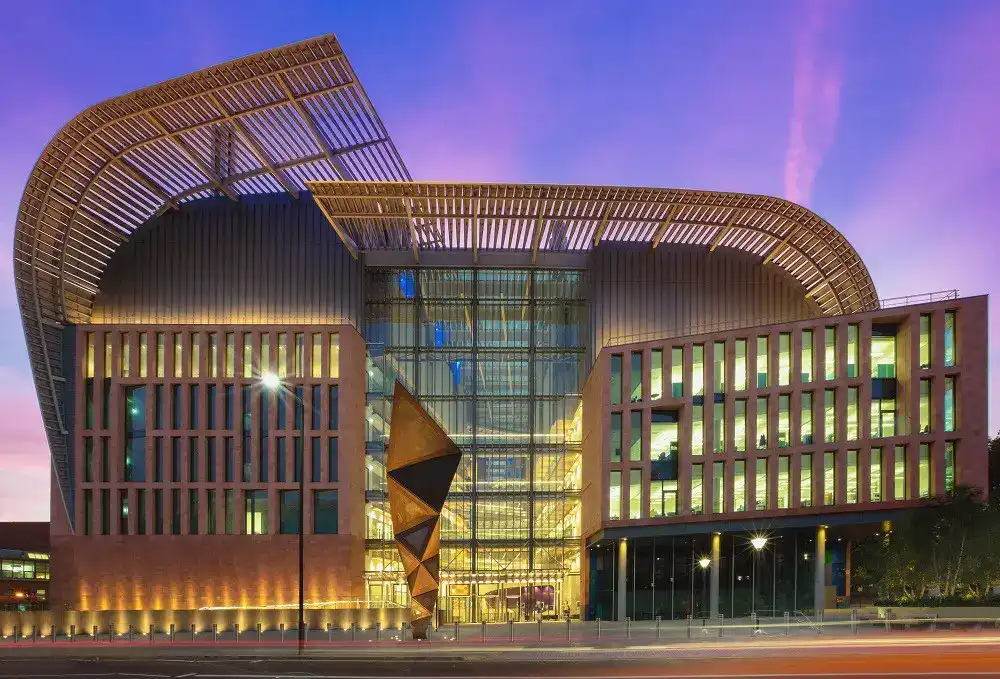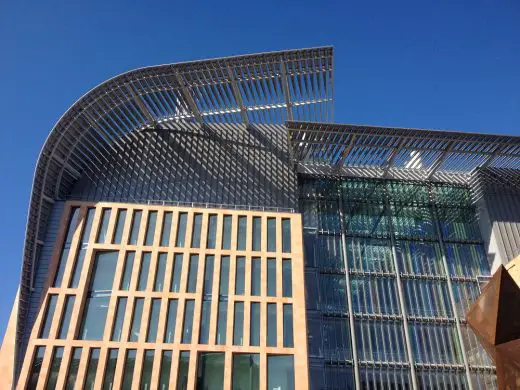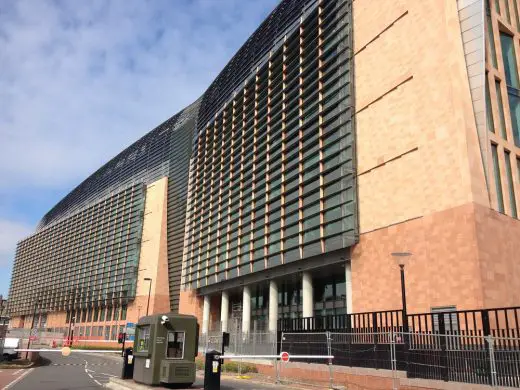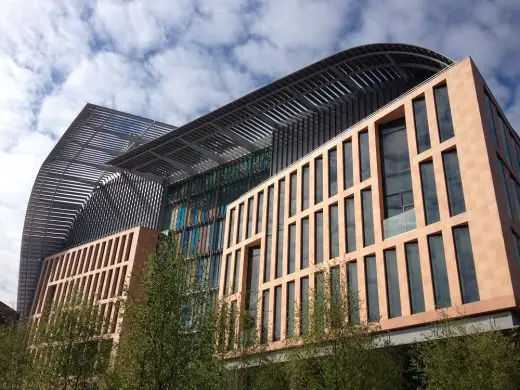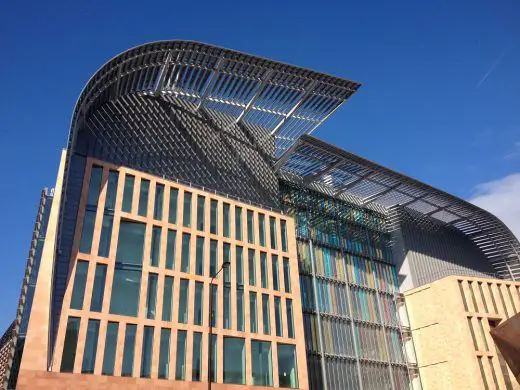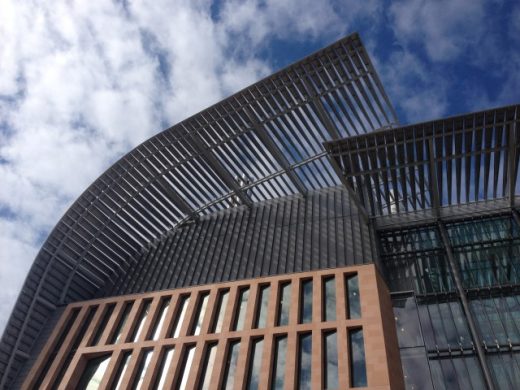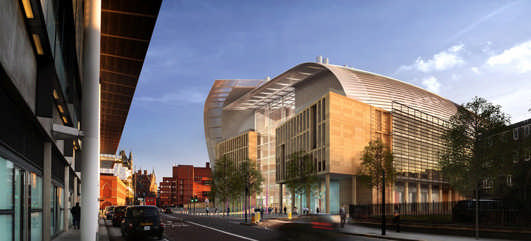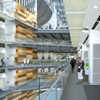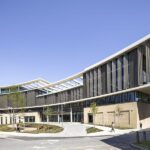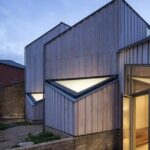The Francis Crick Institute Building, Medical Research London, St Pancras design news
The Francis Crick Institute, London
Kings Cross Medical Research Building, UK design by HOK / PLP architecture
Medical Research Building
Location: Kings Cross, North London, England
Design: HOK with sub-consultant PLP
HOK / PLP Architecture-Designed Francis Crick Institute Recognised As “Lab of the Year”
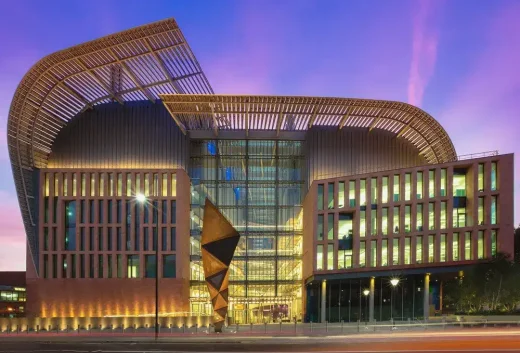
photo © Chris Ansell DiffusedLight Photography
20 Apr 2016 – new photos loaded ; 7 Jun 2013
The Francis Crick Institute
The Francis Crick Institute, which opened last year in central London as one of Europe’s largest biomedical and translational research centres, has been named R&D Magazine’s 2017 Laboratory of the Year.
HOK’s London office acted as architect and lead designer responsible for the institute’s overall design concept, lab planning, interior design and landscape architecture. PLP Architecture collaborated with HOK, leading the project through planning and helping to shape the building’s distinctive form and striking architectural expression.
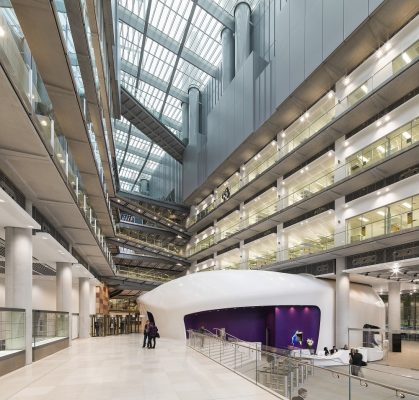
photo © Chris Ansell DiffusedLight Photography
Named after the scientist who helped discover the structure of DNA, the Francis Crick Institute represents a paradigm shift for biomedical research in the UK and the global research community. The 980,000-sq.-ft. building is home to a landmark partnership between the UK’s three largest funders of biomedical research—the Medical Research Council, Cancer Research UK and the Wellcome Trust—and three of its leading universities: University College London, Imperial College London and King’s College London.
“More than just sharing a building, these organisations have partnered as a diverse community of researchers working together in interdisciplinary teams,” said Bill Odell, FAIA, LEED AP, HOK’s firm-wide director of Science + Technology based in St. Louis.
The design encourages collaboration and interaction among multidisciplinary Crick researchers including biologists, chemists, physicists, engineers, computer scientists and mathematicians. The facility is divided into four lab neighbourhoods connected by two atria that bring daylight into all of the labs and other spaces. The atria cross at the centre of the building to create a hub with break-out areas, informal collaboration space, a large central stair and a concierge serving the entire floor.
“One of the Crick’s strategic priorities—‘to pursue discovery without boundaries’—emphasises the importance of its workplace environment,” said Odell. “Its researchers are encouraged to explore their scientific curiosities, with almost no idea being off limits.”
Glass walls allow for views into labs, promoting transparency and openness. Unless specific functions require closed walls, lab neighbourhoods are open to encourage interaction. Walkways and informal meeting areas crisscross the main atrium and connect neighbourhoods.
Designed with flexibility, lab neighbourhoods can support rapid reconfiguration as research programs change. A centralised service distribution system enables a kit-of-parts approach in which predetermined components can be plugged into service spines in different combinations.
Now in its 51st year, the Laboratory of the Year Awards recognise excellence in research laboratory design, planning and construction worldwide. Judging of the annual international competition was conducted by a blue-ribbon panel of laboratory architects, engineers, equipment manufacturers, and researchers together with the editors of R&D Magazine and Laboratory Design.
FRANCIS CRICK INSTITUTE TOPS OUT
7th June 2013 – Located in the heart of London, the Francis Crick Institute, a world class interdisciplinary medical research institute designed by lead architect HOK (with sub-consultant PLP), topped out yesterday.
The Francis Crick Institute
Design: HOK / PLP
The ceremony, which coincided with the publication of the Crick’s scientific strategy, was attended by Chief Executives from the Crick’s partners, The Chancellor of the Exchequer, George Osborne MP; the Minister for Universities and Science, David Willetts MP; and Earl Howe, Parliamentary Under Secretary of State, Department of Health.
A landmark partnership between the UK’s three largest funders of biomedical research: the Medical Research Council; Cancer Research UK and the Wellcome Trust and three of its leading universities: UCL; Imperial College London and King’s College London, the institute will combine specialist knowledge, expertise and resources from each of these organisations to encourage ground-breaking research. Through exceptional cooperation, the institute will tackle major scientific problems and generate solutions to the emerging health challenges of the 21st century. It will carry out discovery biomedical research to help better understand why disease develops and to find new ways to diagnose, prevent and treat a range of illnesses such as cancer, heart disease and stroke, infections and neurodegenerative diseases.
As lead architect for the Francis Crick Institute, HOK was tasked with creating a world class, state-of-the-art scientific facility that would encourage collaboration and innovation through flexible and forward thinking design. The interior of the building balances the need to provide formal research areas with a mix of informal break out areas designed to draw people from different organisations together. An auditorium, exhibition area and teaching lab located adjacent the main entrance, underline the Crick’s fundamental ethos of collaboration, communication and community engagement, demystifying and opening up the space to the local community and visitors.
The exterior of the building provides strong links between the new institute and the historic buildings in the local area. Both the masonry and the distinctive vaulted roof recall features of the adjacent St Pancras International station, whilst the large cantilevered bay windows along with tall glass atria reduce the impact of the building at street level and maintain natural light in both work and public areas. The main eastern entrance, opposite St Pancras International, faces a new public square on Midland Road, whilst at the western side of the building, a public garden framed by trees and benches will be created.
Francis Crick Institute topping out:



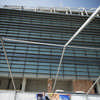
photos : Wellcome Library
Speaking ahead of the topping out ceremony, Sir Paul Nurse, Director of the Francis Crick Institute, said: “We’re delighted to be celebrating this important moment in the construction of the institute. From the outset, the Francis Crick Institute has been an unprecedented collaboration between the UK’s leading medical research organisations, academic institutions and industry. Our uncompromising commitment to excellence, our emphasis on multi-disciplinary research, our focus on young and emerging talent, our novel ways of partnership working, and our plans to export our best people to other institutions across the UK, are some of the factors that will set the Crick apart.”
HOK Director David King commented: “Today marks an exciting milestone for HOK and the Francis Crick Institute. The Crick, a world-class facility based right here in London, will ensure the UK remains at the forefront of biomedical research. Its success relies on collaboration and at HOK we have combined our proven track record in designing complex, state-of-the-art scientific research facilities, with our expertise in designing the very best in flexible, forward thinking interiors. The result will be a space that not only allows, but actively encourages, the sharing of knowledge and collaboration, distinguishing the Crick from other facilities and helping to attract some of the world’s best scientific talent to our Capital.”
Francis Crick Institute topping out:




photos : Wellcome Library
The Francis Crick Institute London – Building Information
• Architects: HOK (lead architect), PLP (sub consultant for exterior facade)
• Design and build contractor: Laing O’Rourke
• Current status: under construction
• Expected completion date: 2015
The Francis Crick Institute will be a world-leading centre of biomedical research and innovation. It will promote connections between researchers, between disciplines, and between academic institutions, healthcare organisations and businesses. Dedicated to research excellence, the institute will have the scale, vision and expertise to tackle challenging scientific questions underpinning health and disease.
Due to open in 2015, The Francis Crick Institute is a charity supported by the Medical Research Council, Cancer Research UK, the Wellcome Trust, UCL (University College London), Imperial College London and King’s College London. It will be world-class with a strong national role – training scientists and developing ideas for public good.
HOK has designed some of the world’s most innovative health sciences facilities, including the award-winning King Abdullah University of Science and Technology (KAUST) in Saudi Arabia and the University of Chicago’s William Eckhardt Research Center.
The Francis Crick Institute London images / information from HOK
Bio Medical Research Centre
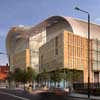
image from architects
Location: Brill Place, London, England, UK
King’s Cross London Building Designs
Contemporary King’s Cross London Architecture Designs
The Apex
Design: Bennetts Associates, Architects
The Apex Kings Cross
Design: de Metz Forbes Knight Architects (dMFK)
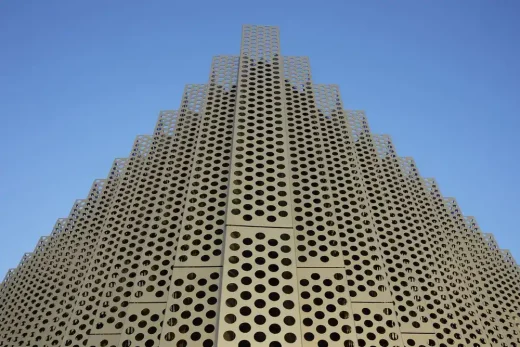
photo © Jack Hobhouse/span>
York House Kings Cross
King’s Cross Central Competition
King’s Cross Building
Design: Bennetts Associates
King’s Cross Square : Competition Shortlist
London Building Designs
London Architecture Designs
London Architecture Designs – chronological list
London Architecture Walking Tours – tailored UK capital city walks by e-architect
University College Hospital Building
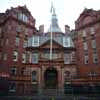
picture © Adrian Welch
UCL Cancer Institute Building
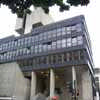
picture © Adrian Welch
School of Tropical Medicine, UCL
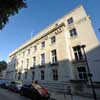
photograph © Nick Weall
Comments / photos for the The Francis Crick Institute page welcome
Website: www.crick.ac.uk

